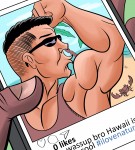The time has come to book our spring break trips, which means I’ll soon engage in a game of Where’s Waldo? on my Instagram feed, working out who is lounging on a remote beach, afoot European streets or hiking steep mountain ranges.
Posting pictures of yourself on vacation on social media is such an integral part of our experience these days that it even has multiple names. Call it “vacation envy” or “fear of missing out,” it all boils down to one thing: people love to show off where they travel, and we love to hate them for it.
Many of us are guilty of arriving at a new destination, taking a picture, dressing it up with a nice filter and alerting all our followers that we are on vacation. A recent survey done by a United Kingdom rental home insurance firm shows the most important factor among millennials when choosing a place to vacation is its “Instagrammability.”
Research done by the popular dating apps Hinge and Tinder also shows that both traveling or expressing one’s desire to do so is a fundamental part of a person’s profile. Hinge found in 2017 that a traveling picture on someone’s dating profile tends to get 30 percent more likes than an average photo might.
Sharing posts
But why is traveling so shareable? It’s not particularly complicated to understand – we have always loved to share our adventures when we are far away from home. A historical look at this phenomenon equates the average Instagram travel post as the evolutionary progression of the postcard.
As obsolete as it may seem now, postcards were once the primary means of sharing travel experiences starting in the late 1800s. When they first arrived in American society, postcards suggested high socioeconomic status as only the wealthy could afford lengthy trips.
Similarly, an article from Vox detailing the appeal of social media and traveling shows that posting pictures on Instagram about our travels connotes high-income. The idea that one would spend money on intangible things or have a significant excess of income to vacation, breathes insight into the social class of the user.
The science of oversharing
In the 1950s, psychologist Leon Festinger popularized the theory of social comparison. This idea presents the argument that as human beings we tend to evaluate ourselves in comparison to others. This is due to our desire to form part of a group and to live and associate with others.
Social media satisfies this need to be a part of a community. Much more than a device of communication, joining a social network is a means of association. Thus, as we associate with one another, our self-esteem becomes a product of comparison – and there is no better mechanism for comparison than social media.
“That’s why I deleted my Instagram. I was tired of looking at people on the beach while I was on my couch at home,” said Leah Carrere, a first-year undeclared student. “It was lowering my self-esteem.”
But why do we choose to share our experiences on social media? A study by the Tourism Management journal analyzed the motivations for people sharing their travel experiences on social media. They identified two different types of sharing – those related to personal values versus community values.
Community value sharing tends to be the reason why websites like TripAdvisor or Yelp seem so prominent in a travel experience. People share their trip in order to positively impact other peoples’ decision making. However, community values are also the reason why we send pictures to our friends and family members; it’s a way to maintain relationships when one is far away.
Social media sharing, on the other hand, tends to be more related to personal values. This is classified as the gaining of social capital.
Social capital is hard to define, as it has held many different meanings throughout time. However, the most accepted definition is that the term accounts for the need to bond with our close friends and families and bridge our acquaintances. When people put their pictures on social media networks they do so as to gain recognition, as a statement of belonging within their friends and acquaintances.
“I understand why people (post pictures of the places they go). It feels good to show off (the fact that) you are living your best life to the people you know,” said Palmer Turnbull, a first-year political science student.
Whether it is a statement of being “cultured,” being of higher socioeconomic standing, or that we are living our best lives, it seems as though posting pictures of our traveling always suggests something positive. It sends a message of good social standing and that’s motivation enough to share it.
Long and stressful study sessions are not as glamorous as going on vacation. There are very few people who would choose to lounge at home over roaming the streets of Paris or going hiking in the Grand Canyon. However, there is one thing these mundane acts have that travel envy blogs on Instagram do not – they are real. They reinforce the idea that we don’t all spend our lives jet-setting from one destination to the next.
We spend a small percentage of our year traveling, but it often feels like such a huge part of our social media personas. Our Instagrammable lives can exist in conflict with our real ones – be it on the couch or on a beach, it is clear that what we may just want is to be “liked.”
